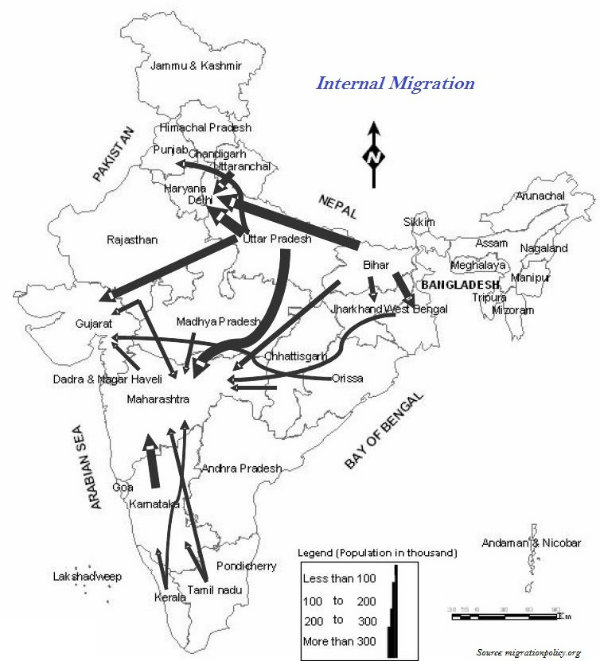
- Geography India - Introduction
- Geography India - Physical Aspect
- Geography India - Drainage System
- Geography India - Climate
- Geography India - Natural Vegetation
- Geography India - National Forest
- Geography India - Wildlife
- Geography India - Soil
- Geography India - Land Resources
- Geography India - Agriculture
- Geography India - Mineral Resources
- Geography India - Energy Resources
- Geography India - Industry
- Geography India - Transport
- Geography India - Communication
- Geography India - Foreign Trade
- Geography India - The People
- Geography India - Settlement
- Geography India - Migration
- Regional Development
- Geography India - Disasters
- Geography of the World
- Geography World - Introduction
- Evolution of the Earth
- Geography World - Climate
- Geography World - Transport
- Geography World - Communications
- Geography World - Population
- Human Settlement
- Human Development
- International Trade
- Geography Useful Resources
- Geography - Online Quiz
- Geography - Online Test
- Geography - Quick Guide
- Geography - Useful Resources
- Geography - Discussion
Geography India - Migration
Introduction
During colonial period (i.e. British period) millions of the indentured laborers were sent to Mauritius, Caribbean islands (Trinidad & Tobago and Guyana), Fiji, and South Africa by British Government largely from the states of Uttar Pradesh and Bihar.

All such migrations were covered under time-bound contracts known as Girmit Act (Indian Emigration Act).
The recent wave of migrants consists of professionals including software engineers, doctors, engineers, management consultants, financial experts, and media persons to countries like USA, Canada, UK, Australia, New Zealand, Germany, etc.
Migration Facts
The first major modification was done in 1961 Census, as two additional components i.e. place of birth (village or town) and duration of residence (if born elsewhere) were added.
Further, in 1971, another component added i.e. on place of last residence and duration of stay at the place of enumeration.
In 1981, Information on reasons for migration were incorporated.
According to 2001 census, out of total 1,029 million population, 307 million (30 per cent) were reported as migrants in terms of place of birth.
Under the intra-state migration, numbers of female migrants are more than male (marriage related migration).
As per the census 2001, India has recorded that more than 5 million persons have migrated to India from other countries; largely, from the neighboring countries including Bangladesh, Nepal, and Pakistan.
As per the census 2001, there are about 20 million people of Indian Diaspora, spread across the 110 countries of the world.
In terms of in-migration, Maharashtra occupied the first place (2.3 million net in-migrants), followed by Delhi, Gujarat, and Haryana.
On the other hand, in terms of out-migration, Uttar Pradesh (-2.6 million) and Bihar (-1.7 million) were the top states.
In terms of the urban agglomeration (UA), Greater Mumbai had received the maximum number of in-migrants.
Causes of Migration
Causes of migration are categorized as push factor and pull factor.
Push factors force people to migrate; for example, unemployment, lack of infrastructure (such as hospital, education institutions, etc.), natural disasters (such as flood, drought, earthquake, cyclone, etc.), local conflicts, war, etc.
Pull factors attract people from different places; for example, better opportunities for education and employment; better health facilities; and various sources of entertainment, etc.

Normally, the reason behind female migration throughout India is largely marriage related; however, Meghalaya has a reverse scenario.
Remittances from the international migrants are one of the major sources of foreign exchange.
For thousands of the poor villages of states like Bihar, Uttar Pradesh, Odisha, Andhra Pradesh, Himachal Pradesh, etc. remittance acts as life blood for their subsistence.
Impacts of Migration
Development of slums in industrially developed states, such as Maharashtra, Gujarat, Karnataka, Tamil Nadu, and metropolitan areas, such as Delhi, Mumbai, Kolkata, etc. is a negative consequence of unregulated migration within the country.
One of the major negative impacts of migration is imbalances in age and sex composition at both the places − sending region (out-migration) and receiving region (in-migration).
Migration intermixes people of diverse cultural backgrounds
Because of unbalanced migration, the receiving regions (especially urban areas) are facing many environmental problems, such as pollution, depletion of ground water, solid waste management problems, etc.